YAMAHA TTR50 2013 Manual PDF
Manufacturer: YAMAHA, Model Year: 2013, Model line: TTR50, Model: YAMAHA TTR50 2013Pages: 86, PDF Size: 1.8 MB
Page 71 of 86
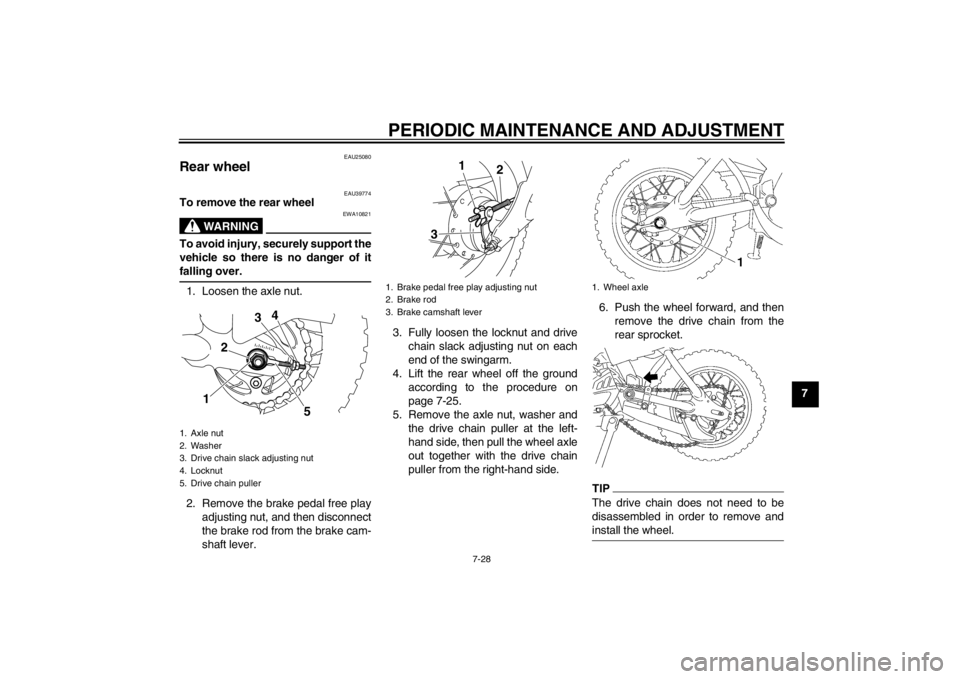
PERIODIC MAINTENANCE AND ADJUSTMENT
7-28
7
EAU25080
Rear wheel
EAU39774
To remove the rear wheel
WARNING
EWA10821
To avoid injury, securely support the
vehicle so there is no danger of it
falling over.1. Loosen the axle nut.
2. Remove the brake pedal free playadjusting nut, and then disconnect
the brake rod from the brake cam-
shaft lever. 3. Fully loosen the locknut and drive
chain slack adjusting nut on each
end of the swingarm.
4. Lift the rear wheel off the ground according to the procedure on
page 7-25.
5. Remove the axle nut, washer and the drive chain puller at the left-
hand side, then pull the wheel axle
out together with the drive chain
puller from the right-hand side. 6. Push the wheel forward, and then
remove the drive chain from the
rear sprocket.
TIPThe drive chain does not need to be
disassembled in order to remove and
install the wheel.
1. Axle nut
2. Washer
3. Drive chain slack adjusting nut
4. Locknut
5. Drive chain puller
1
5
4
3
2
1. Brake pedal free play adjusting nut
2. Brake rod
3. Brake camshaft lever
1
2
3
1. Wheel axle
U2CJ80E0.book Page 28 Tuesday, June 12, 2012 11:15 AM
Page 72 of 86
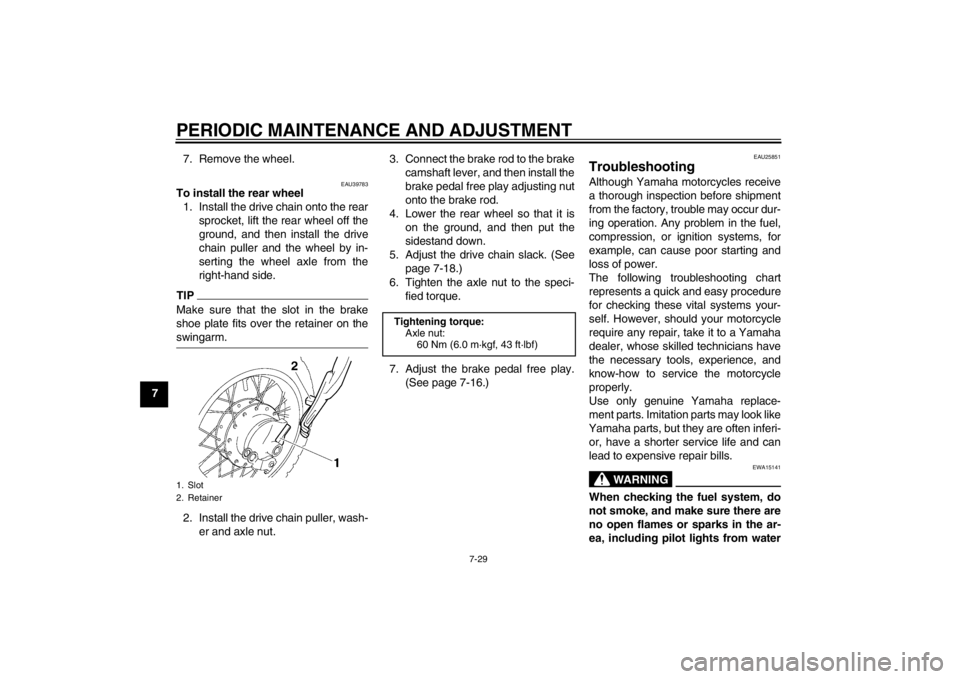
PERIODIC MAINTENANCE AND ADJUSTMENT
7-29
77. Remove the wheel.
EAU39783
To install the rear wheel
1. Install the drive chain onto the rear sprocket, lift the rear wheel off the
ground, and then install the drive
chain puller and the wheel by in-
serting the wheel axle from the
right-hand side.TIPMake sure that the slot in the brake
shoe plate fits over the retainer on the
swingarm.2. Install the drive chain puller, wash-er and axle nut. 3. Connect the brake rod to the brake
camshaft lever, and then install the
brake pedal free play adjusting nut
onto the brake rod.
4. Lower the rear wheel so that it is on the ground, and then put the
sidestand down.
5. Adjust the drive chain slack. (See page 7-18.)
6. Tighten the axle nut to the speci- fied torque.
7. Adjust the brake pedal free play. (See page 7-16.)
EAU25851
Troubleshooting Although Yamaha motorcycles receive
a thorough inspection before shipment
from the factory, trouble may occur dur-
ing operation. Any problem in the fuel,
compression, or ignition systems, for
example, can cause poor starting and
loss of power.
The following troubleshooting chart
represents a quick and easy procedure
for checking these vital systems your-
self. However, should your motorcycle
require any repair, take it to a Yamaha
dealer, whose skilled technicians have
the necessary tools, experience, and
know-how to service the motorcycle
properly.
Use only genuine Yamaha replace-
ment parts. Imitation parts may look like
Yamaha parts, but they are often inferi- or, have a shorter service life and can
lead to expensive repair bills.
WARNING
EWA15141
When checking the fuel system, do
not smoke, and make sure there are
no open flames or sparks in the ar-
ea, including pilot lights from water
1. Slot
2. Retainer
Tightening torque: Axle nut:60 Nm (6.0 m·kgf, 43 ft·lbf)
U2CJ80E0.book Page 29 Tuesday, June 12, 2012 11:15 AM
Page 73 of 86
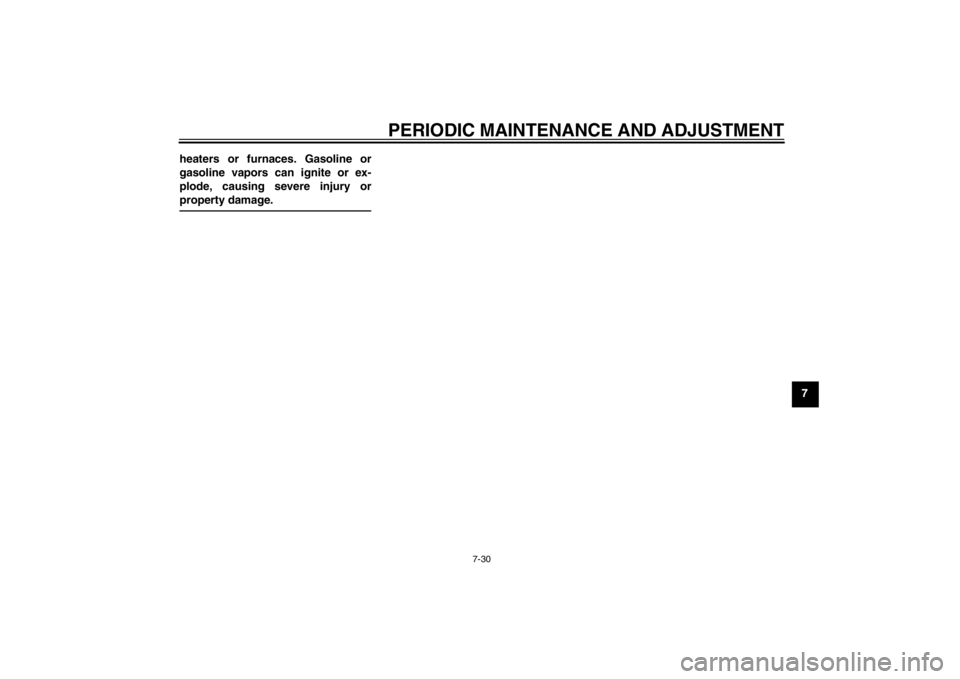
PERIODIC MAINTENANCE AND ADJUSTMENT
7-30
7
heaters or furnaces. Gasoline or
gasoline vapors can ignite or ex-
plode, causing severe injury or
property damage.
U2CJ80E0.book Page 30 Tuesday, June 12, 2012 11:15 AM
Page 74 of 86
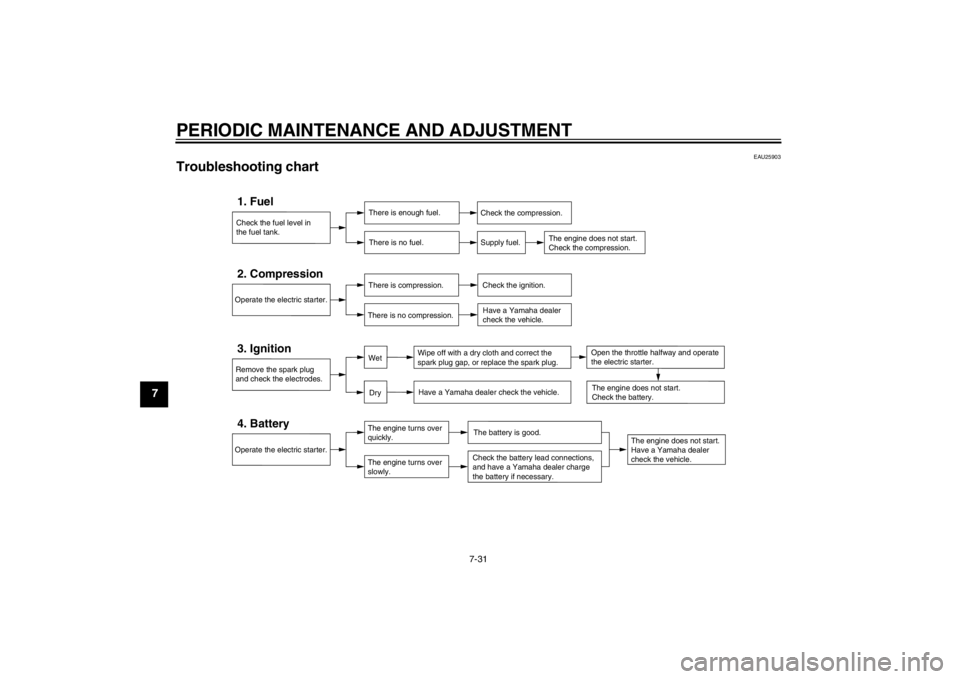
PERIODIC MAINTENANCE AND ADJUSTMENT
7-31
7
EAU25903
Troubleshooting chart
Check the fuel level in
the fuel tank.1. Fuel
There is enough fuel.There is no fuel.
Check the compression.
Supply fuel.
The engine does not start.
Check the compression.
Operate the electric starter.2. Compression
There is compression.
There is no compression.
Check the ignition. Have a Yamaha dealer
check the vehicle.
Remove the spark plug
and check the electrodes.3. Ignition
Wipe off with a dry cloth and correct the
spark plug gap, or replace the spark plug.
Have a Yamaha dealer check the vehicle.
The engine does not start.
Have a Yamaha dealer
check the vehicle.
The engine does not start.
Check the battery.
Operate the electric starter.4. Battery
The engine turns over
quickly.
The engine turns over
slowly.
The battery is good.Check the battery lead connections,
and have a Yamaha dealer charge
the battery if necessary.
DryWet
Open the throttle halfway and operate
the electric starter.
U2CJ80E0.book Page 31 Tuesday, June 12, 2012 11:15 AM
Page 75 of 86
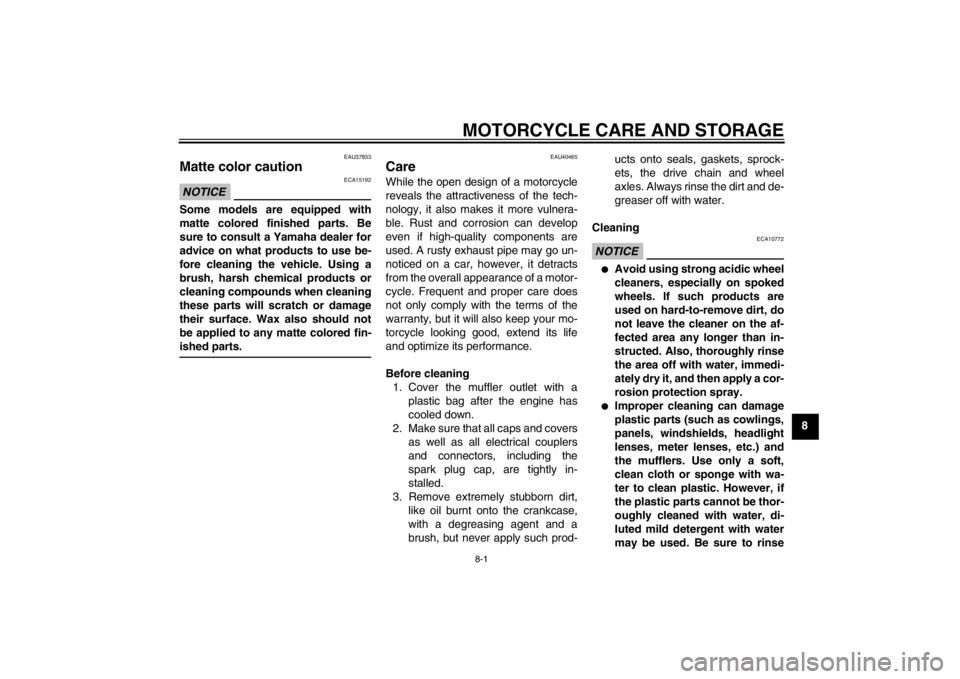
MOTORCYCLE CARE AND STORAGE
8-1
8
EAU37833
Matte color caution NOTICE
ECA15192
Some models are equipped with
matte colored finished parts. Be
sure to consult a Yamaha dealer for
advice on what products to use be-
fore cleaning the vehicle. Using a
brush, harsh chemical products or
cleaning compounds when cleaning
these parts will scratch or damage
their surface. Wax also should not
be applied to any matte colored fin-
ished parts.
EAU40465
Care While the open design of a motorcycle
reveals the attractiveness of the tech-
nology, it also makes it more vulnera-
ble. Rust and corrosion can develop
even if high-quality components are
used. A rusty exhaust pipe may go un-
noticed on a car, however, it detracts
from the overall appearance of a motor-
cycle. Frequent and proper care does
not only comply with the terms of the
warranty, but it will also keep your mo-
torcycle looking good, extend its life
and optimize its performance.
Before cleaning1. Cover the muffler outlet with a plastic bag after the engine has
cooled down.
2. Make sure that all caps and covers as well as all electrical couplers
and connectors, including the
spark plug cap, are tightly in-
stalled.
3. Remove extremely stubborn dirt, like oil burnt onto the crankcase,
with a degreasing agent and a
brush, but never apply such prod- ucts onto seals, gaskets, sprock-
ets, the drive chain and wheel
axles. Always rinse the dirt and de-
greaser off with water.
Cleaning
NOTICE
ECA10772
●
Avoid using strong acidic wheel
cleaners, especially on spoked
wheels. If such products are
used on hard-to-remove dirt, do
not leave the cleaner on the af-
fected area any longer than in-
structed. Also, thoroughly rinse
the area off with water, immedi-
ately dry it, and then apply a cor-
rosion protection spray.
●
Improper cleaning can damage
plastic parts (such as cowlings,
panels, windshields, headlight
lenses, meter lenses, etc.) and
the mufflers. Use only a soft,
clean cloth or sponge with wa-
ter to clean plastic. However, if
the plastic parts cannot be thor-
oughly cleaned with water, di-
luted mild detergent with water
may be used. Be sure to rinse
U2CJ80E0.book Page 1 Tuesday, June 12, 2012 11:15 AM
Page 76 of 86

MOTORCYCLE CARE AND STORAGE
8-2
8off any detergent residue using
plenty of water, as it is harmful
to plastic parts.
●
Do not use any harsh chemical
products on plastic parts. Be
sure to avoid using cloths or
sponges which have been in
contact with strong or abrasive
cleaning products, solvent or
thinner, fuel (gasoline), rust re-
movers or inhibitors, brake flu-
id, antifreeze or electrolyte.
●
Do not use high-pressure wash-
ers or steam-jet cleaners since
they cause water seepage and
deterioration in the following ar-
eas: seals (of wheel and swing-
arm bearings, fork and brakes),
electric components (couplers,
connectors, instruments,
switches and lights), breather
hoses and vents.
●
For motorcycles equipped with
a windshield: Do not use strong
cleaners or hard sponges as
they will cause dulling or
scratching. Some cleaning com-
pounds for plastic may leave
scratches on the windshield. Test the product on a small hid-
den part of the windshield to
make sure that it does not leave
any marks. If the windshield is
scratched, use a quality plastic
polishing compound after
washing.
After normal useRemove dirt with warm water, a mild
detergent, and a soft, clean sponge,
and then rinse thoroughly with clean
water. Use a toothbrush or bottlebrush
for hard-to-reach areas. Stubborn dirt
and insects will come off more easily if
the area is covered with a wet cloth for
a few minutes before cleaning.
After riding in the rain or near the seaSince sea salt is extremely corrosive,
carry out the following steps after each
ride in the rain or near the sea.
1. Clean the motorcycle with cold wa- ter and a mild detergent, after the
engine has cooled down.
NOTICE: Do not use warm water
since it increases the corrosive
action of the salt.
[ECA10791]
2. Apply a corrosion protection spray on all metal, including chrome- and
nickel-plated, surfaces to prevent
corrosion.
After cleaning 1. Dry the motorcycle with a chamois or an absorbing cloth.
2. Immediately dry the drive chain and lubricate it to prevent it from
rusting.
3. Use a chrome polish to shine chrome, aluminum and stainless-
steel parts, including the exhaust
system. (Even the thermally in-
duced discoloring of stainless-
steel exhaust systems can be re-
moved through polishing.)
4. To prevent corrosion, it is recom- mended to apply a corrosion pro-
tection spray on all metal,
including chrome- and nickel-plat-
ed, surfaces.
5. Use spray oil as a universal clean- er to remove any remaining dirt.
6. Touch up minor paint damage caused by stones, etc.
7. Wax all painted surfaces.
U2CJ80E0.book Page 2 Tuesday, June 12, 2012 11:15 AM
Page 77 of 86
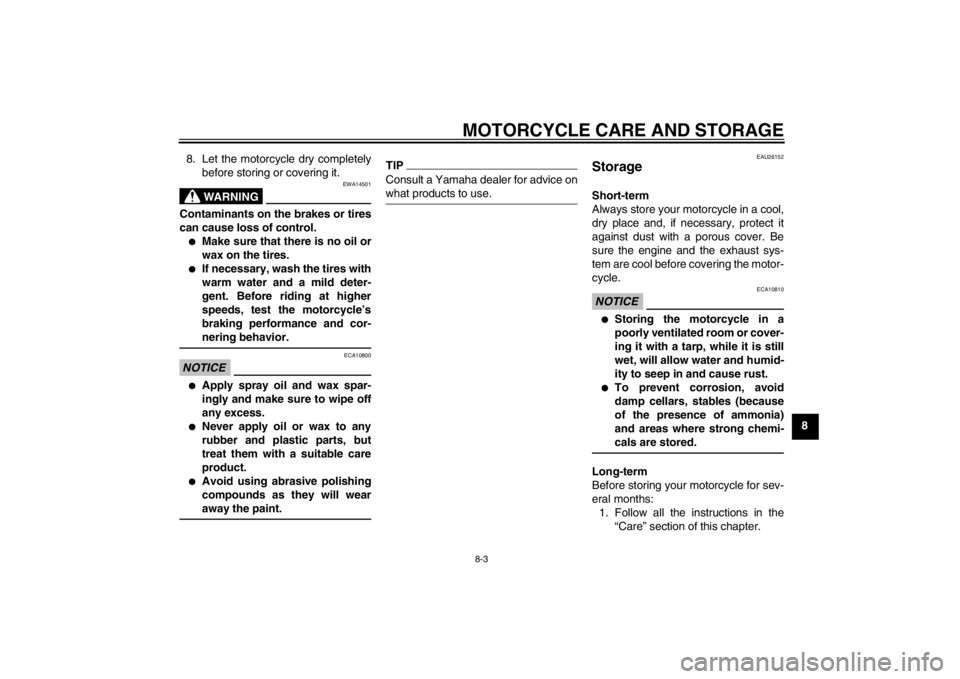
MOTORCYCLE CARE AND STORAGE
8-3
8
8. Let the motorcycle dry completely
before storing or covering it.
WARNING
EWA14501
Contaminants on the brakes or tires
can cause loss of control.●
Make sure that there is no oil or
wax on the tires.
●
If necessary, wash the tires with
warm water and a mild deter-
gent. Before riding at higher
speeds, test the motorcycle’s
braking performance and cor-
nering behavior.
NOTICE
ECA10800
●
Apply spray oil and wax spar-
ingly and make sure to wipe off
any excess.
●
Never apply oil or wax to any
rubber and plastic parts, but
treat them with a suitable care
product.
●
Avoid using abrasive polishing
compounds as they will wear
away the paint.
TIPConsult a Yamaha dealer for advice on
what products to use.
EAU26152
Storage Short-term
Always store your motorcycle in a cool,
dry place and, if necessary, protect it
against dust with a porous cover. Be
sure the engine and the exhaust sys-
tem are cool before covering the motor-
cycle.NOTICE
ECA10810
●
Storing the motorcycle in a
poorly ventilated room or cover-
ing it with a tarp, while it is still
wet, will allow water and humid-
ity to seep in and cause rust.
●
To prevent corrosion, avoid
damp cellars, stables (because
of the presence of ammonia)
and areas where strong chemi-
cals are stored.
Long-term
Before storing your motorcycle for sev-
eral months:1. Follow all the instructions in the “Care” section of this chapter.
U2CJ80E0.book Page 3 Tuesday, June 12, 2012 11:15 AM
Page 78 of 86
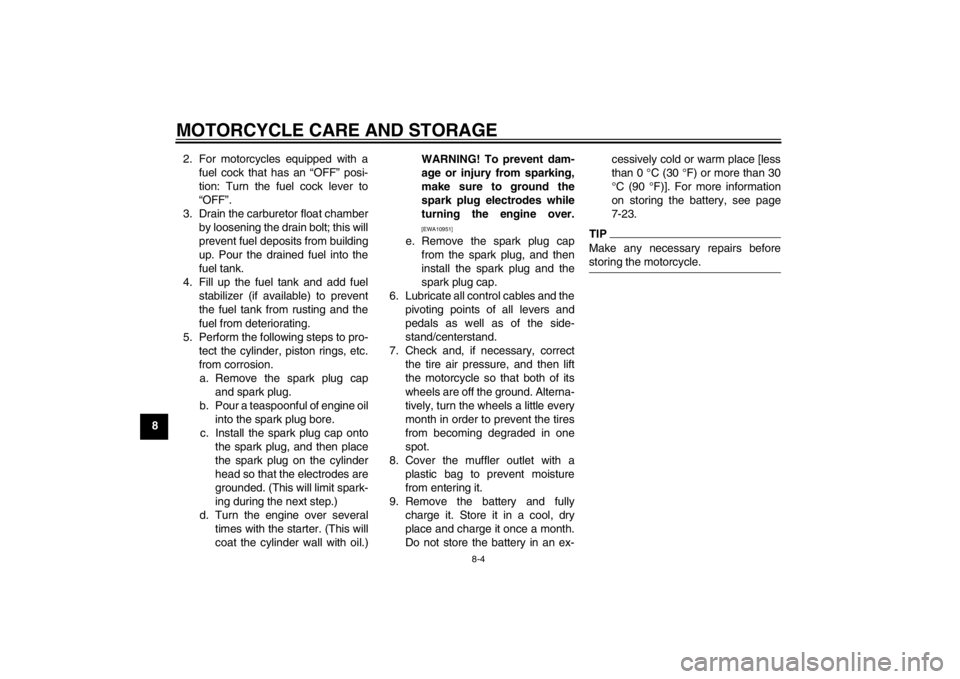
MOTORCYCLE CARE AND STORAGE
8-4
82. For motorcycles equipped with a
fuel cock that has an “OFF” posi-
tion: Turn the fuel cock lever to
“OFF”.
3. Drain the carburetor float chamber by loosening the drain bolt; this will
prevent fuel deposits from building
up. Pour the drained fuel into the
fuel tank.
4. Fill up the fuel tank and add fuel stabilizer (if available) to prevent
the fuel tank from rusting and the
fuel from deteriorating.
5. Perform the following steps to pro- tect the cylinder, piston rings, etc.
from corrosion.a. Remove the spark plug cap and spark plug.
b. Pour a teaspoonful of engine oil into the spark plug bore.
c. Install the spark plug cap onto the spark plug, and then place
the spark plug on the cylinder
head so that the electrodes are
grounded. (This will limit spark-
ing during the next step.)
d. Turn the engine over several times with the starter. (This will
coat the cylinder wall with oil.) WARNING! To prevent dam-
age or injury from sparking,
make sure to ground the
spark plug electrodes while
turning the engine over.
[EWA10951]
e. Remove the spark plug cap from the spark plug, and then
install the spark plug and the
spark plug cap.
6. Lubricate all control cables and the pivoting points of all levers and
pedals as well as of the side-
stand/centerstand.
7. Check and, if necessary, correct the tire air pressure, and then lift
the motorcycle so that both of its
wheels are off the ground. Alterna-
tively, turn the wheels a little every
month in order to prevent the tires
from becoming degraded in one
spot.
8. Cover the muffler outlet with a plastic bag to prevent moisture
from entering it.
9. Remove the battery and fully charge it. Store it in a cool, dry
place and charge it once a month.
Do not store the battery in an ex- cessively cold or warm place [less
than 0 °C (30 °F) or more than 30
°C (90 °F)]. For more information
on storing the battery, see page
7-23.
TIPMake any necessary repairs before
storing the motorcycle.
U2CJ80E0.book Page 4 Tuesday, June 12, 2012 11:15 AM
Page 79 of 86
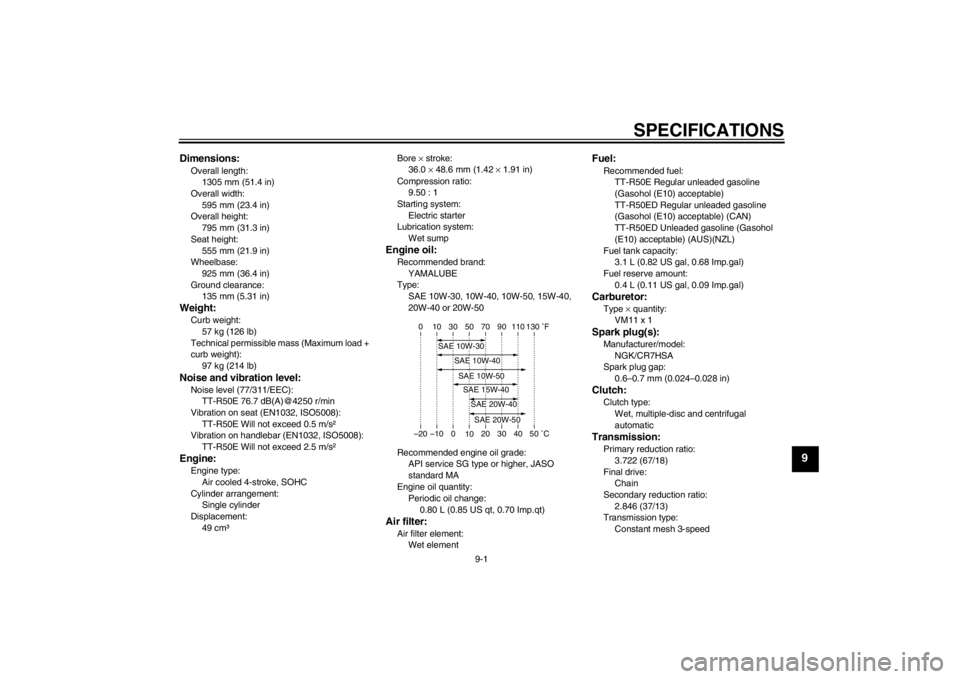
SPECIFICATIONS
9-1
9
Dimensions:Overall length:1305 mm (51.4 in)
Overall width:
595 mm (23.4 in)
Overall height: 795 mm (31.3 in)
Seat height: 555 mm (21.9 in)
Wheelbase:
925 mm (36.4 in)
Ground clearance: 135 mm (5.31 in)Weight:Curb weight:
57 kg (126 lb)
Technical permissible mass (Maximum load +
curb weight):
97 kg (214 lb)Noise and vibration level:Noise level (77/311/EEC):TT-R50E 76.7 dB(A)@4250 r/min
Vibration on seat (EN1032, ISO5008):
TT-R50E Will not exceed 0.5 m/s²
Vibration on handlebar (EN1032, ISO5008): TT-R50E Will not exceed 2.5 m/s²Engine:Engine type:
Air cooled 4-stroke, SOHC
Cylinder arrangement: Single cylinder
Displacement: 49 cm³ Bore
× stroke:
36.0 × 48.6 mm (1.42 × 1.91 in)
Compression ratio: 9.50 : 1
Starting system:
Electric starter
Lubrication system: Wet sump
Engine oil:Recommended brand:
YAMALUBE
Type: SAE 10W-30, 10W-40, 10W-50, 15W-40,
20W-40 or 20W-50
Recommended engine oil grade: API service SG type or higher, JASO
standard MA
Engine oil quantity: Periodic oil change:
0.80 L (0.85 US qt, 0.70 Imp.qt)Air filter:Air filter element:Wet element
Fuel:Recommended fuel:TT-R50E Regular unleaded gasoline
(Gasohol (E10) acceptable)
TT-R50ED Regular unleaded gasoline
(Gasohol (E10) acceptable) (CAN)
TT-R50ED Unleaded gasoline (Gasohol
(E10) acceptable) (AUS)(NZL)
Fuel tank capacity: 3.1 L (0.82 US gal, 0.68 Imp.gal)
Fuel reserve amount: 0.4 L (0.11 US gal, 0.09 Imp.gal)Carburetor:Type × quantity:
VM11 x 1Spark plug(s):Manufacturer/model:
NGK/CR7HSA
Spark plug gap: 0.6–0.7 mm (0.024–0.028 in)Clutch:Clutch type:
Wet, multiple-disc and centrifugal
automaticTransmission:Primary reduction ratio:3.722 (67/18)
Final drive: Chain
Secondary reduction ratio:
2.846 (37/13)
Transmission type: Constant mesh 3-speed
–20 –10 0 1020 30 40 50 �C
10 30 50 70 90 110
0 130 �F
SAE 10W-30
SAE 15W-40SAE 20W-40SAE 20W-50
SAE 10W-40SAE 10W-50
U2CJ80E0.book Page 1 Tuesday, June 12, 2012 11:15 AM
Page 80 of 86

SPECIFICATIONS
9-2
9
Operation:Left foot operation
Gear ratio: 1st: 3.250 (39/12)
2nd: 1.736 (33/19)
3rd:
1.217 (28/23)Chassis:Frame type:Backbone
Caster angle:
25.50 °
Trail: 34 mm (1.3 in)Front tire:Type:
With tube
Size: 2.50-10 4PR
Manufacturer/model: CHENG SHIN/C183A
Speed rating:
100 km/h (62 mph)Rear tire:Type:With tube
Size:
2.50-10 4PR
Manufacturer/model: CHENG SHIN/C183A
Speed rating: 100 km/h (62 mph)
Loading:Maximum rider weight:40.0 kg (88 lb)Tire air pressure (measured on cold
tires):
Front: 100 kPa (1.00 kgf/cm², 15 psi)
Rear:
100 kPa (1.00 kgf/cm², 15 psi)
Front wheel:Wheel type:Spoke wheel
Rim size:
10x1.40Rear wheel:Wheel type:Spoke wheel
Rim size:
10x1.40Front brake:Type:Drum brake
Operation:
Right hand operationRear brake:Type:Drum brake
Operation:
Right foot operationFront suspension:Type:Telescopic fork
Spring/shock absorber type:
Coil spring Wheel travel:
96.0 mm (3.78 in)
Rear suspension:Type:
Swingarm
Spring/shock absorber type: Coil spring/oil damper
Wheel travel: 71.0 mm (2.80 in)Electrical system:Ignition system:DC CDI
Charging system: AC magnetoBattery:Model:GT4B-5
Voltage, capacity: 12 V, 2.5 AhFuse:Fuse:10.0 A
U2CJ80E0.book Page 2 Wednesday, June 27, 2012 11:01 AM